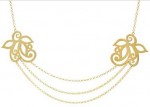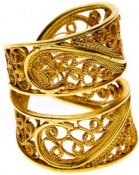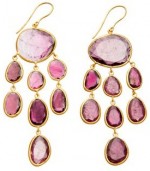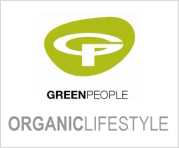Ethical Jewellery – No Longer Compromising Aesthetics for Ethics – Siobhan Maher

Bangles by Daisy Knight
It’s an uncomfortable truth for many jewellers that the industry we love is also an industry fraught with potential environmental and social damage at all stages of manufacture. From mining to production, the process of getting a piece of jewellery from earth to adornment can be damaging to human and environment alike.
Thanks in no small part to the 2006 film ‘Blood Diamond’, consumers are more aware about the importance of asking about the provenance of their diamonds, with few people willing to consider a stone that was not fully compliant with the Kimberley Process. Beyond this, however, it used to be true that consumers knew very little about the other issues surrounding the production of their jewels. Fair-trade jewellery was a niche market, not associated with mainstream commercial product and certainly not considered fashionable.

Necklace by Cred
Happily, the awareness and importance of ethical jewellery is fast gaining momentum without the need for Hollywood intervention. Change is happening, and in exciting times for ethical jewellery consumers are no longer forced to choose between great design and strong ethics. Almost every industry event or trade show now features a seminar or talk on ethical jewellery; it is becoming a growing priority within the industry, with designers and manufacturers alike working to find solutions.
The start of the process, the mining of the metal and gemstones, can very often have the most negative effects. Not only does the very act of mining itself carve into the earth, but the impact on local communities and ecosystems can be devastating. Conditions for mine workers are often very poor – the mines are often dangerously managed, lacking in any health and safety measures, pay is minimal, women are often not paid at all and child labour is commonplace. As with diamonds, the miners of coloured precious stones are often part of an exploitive system where they receive very little money for the stones they produce, which may in turn be used to find violent conflict or oppressive political regimes. The main two chemicals used for extraction of the gold from the ore are cyanide and mercury. Although illegal, mercury is often used by smaller scale mining operations as it is the easiest form of removal and is easily obtained. With little or no safety regulations, miners are often using this toxic material with their hands and breathing in the vapours; causing few short term symptoms but contributing to long term damage to their nervous and motor systems. As well as being hugely damaging to the miners, the chemical finds its way into the atmosphere and water systems – and as with cyanide, waste by-products can escape into the atmosphere and earth if not contained and removed properly. While the current choice for ethical bullion is predominantly recycled product, ethical alternatives have to be found to meet the demand for newly mined silver and gold – and a huge number of people rely on the work, dangerous as it is, to make a living. Fairly mined bullion projects, producing in smaller quantities and at a higher price point, aim to mine metals in a way that reduces the environmental impact and offer the communities and workers a higher wage and higher standard of living.
Fairtrace certified gold launches in February 2011. While no formal certification for coloured stones is yet in place, choosing jewellers that visit the mines their stones come from, work with ethical suppliers to ensure a ‘clean’ source or even only use local stones is a good way to be confident in your gem’s origins.

Cuff by Leblas
Consumers must also be aware about how and where their jewellery was produced. As with any mass-market product, it would be naive to believe it is possible to produce the incredibly cheap pieces currently on the high street and still pay the end worker a fair wage, and the same concerns about child and sweat shop labour in clothing production apply to mass produced jewellery. Of course, there’s no need to pay fine jewellery prices to know that your pieces have been produced fairly – reasonably priced jewellery is still available if you know where to buy it. Made work in conjunction with communities across East Africa to produce their pieces, centred around a strong belief that it is possible to produce fashionable jewellery that has a real, positive impact on developing communities. Respected and ‘of the moment’ designers from the fashion and jewellery worlds design stylish pieces, and with brass pieces starting from around £6 Made are making fashionable fair-trade accessible – and desirable – to all.
As responsible jewellery practices grow in importance, the number and choice of jewellers choosing to work ethically has increased dramatically. Principled consumers no longer have just specific ‘ethical jewellers’ to choose from either – there’s a whole raft of designers taking different approaches to producing ethical jewellery; from the ‘shout it from the rooftops’ jewellers to those who ‘just do it’. Jewellers including Cred, Leblas and Fifi Bijoux have made ethical jewellery exciting, centring their brands around their ethical status but – vitally – backing this up with talented designers producing genuinely trend-aware pieces. Great design gives these brands a vehicle for educating and inspiring customers to choose ethical product – and this is the key to modern ethical jewellery. Other jewellers make it their mission to give back to the communities who inspire or help produce their work, such as Pippa Small – an ‘ethical jeweller’ long before the term was mainstream. An anthropologist as well as a jeweller, she works within indigenous and disadvantaged communities to create self-sufficient income through design projects.

Earrings by Pippa Small
As well as those who specifically market and conduct themselves as an ethical brand, there are also a growing collection of jewellers who recycled bullion and traceable stones in their work without necessarily drawing attention to it, such as Sho Fine Jewellery and Daisy Knights. Just as most of us recycle or watch our carbon footprints as a general part of our lifestyle, these jewellers put their design and branding first, but choose responsible materials and practises as a matter of course. Consumers no longer have to feel limited to buying from specialised brands to ensure they’re getting ethical product – you may just find that the bracelet that caught your eye in Vogue has as strong ethical credentials as fashion ones. It’s true that many brands are unwilling or unable to invest in fair-trade product in these economic times, uncertain that consumer demand justifies the investment. However, it’s never been easier for consumers to show that the demand is there. More than ever, it’s possible to shop ethically for jewellery without compromising on really incredible, fashionable design – especially if you know where to look and the questions to ask.
There’s still an awfully long way to go for the industry as a whole, but ethical jewellery is not a short-lived trend. With both big name and exciting up and coming designers choosing to explore how they can work ethically, there’s so much choice for consumers who care about how the impact their jewellery has – in all senses of the word.
Women
A wide selection of stylish fashion clothing for all occasions including: dresses, tops, knitwear, skirts, eveningwear, coats, suits, jackets and more. Styles to suit a variety of tastes from classic to vintage and more in between: recycled and upcycled. This is sustainable ethical fashion at it's best.
Women's Ethical ClothingMen
If you're looking for something eco or ethical to wear for dress down friday, a casual weekend or holiday, you'll find it here. Tops, t-shirts, jeans, trousers from mainly fairtrade and organic cotton.
Men's Ethical FashionKids
Green fashion for kids is fun and made mainly from natural fibres including organic cotton and Fairtrade cotton. From baby to early teens, there's something to make all kids happy. Bright colours, animals, fun shapes that children can wear all year round.
Kids Green ClothingAccessories
A treasure trove of accessories from around the world can be found here. A vast selection of jewellery including necklaces, bracelets, rings and earrings to shoes, hats, bags, handbags and scarves. Whatever your style, these items will complete any outfit.
Eco-Friendly Accessories





Comments are closed.